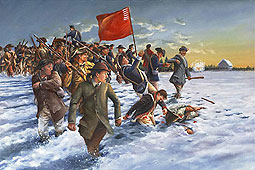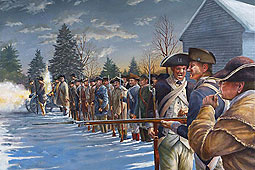For Teachers: Lessons
Lesson 5: A Bloody Encounter: “the body of the people assembled in arms”
Learning Objectives
After completing this lesson, students will be able to:
- Describe what happened at the Arsenal on January 25, 1787
- Explain why the Regulators marched on the Arsenal
- Explain what the government thought of this action
- Offer possible explanations as to why Day’s forces never arrived at the Arsenal
- Compare and contrast how each side viewed the other
- Discuss the meaning of the word “patriot” and make the case for whether the Regulators or the militia, or both, were patriots
- Differentiate among, and evaluate, the terms used to describe Shays and his forces
- Examine and analyze primary source materials
- Analyze maps
Skills
- Interpreting visual information
- Observing and describing
- Thinking critically
- Expressing opinions
- Analyzing visually
- Understanding historical perspective
- Gathering and using information
- Interpreting information
Introduction
In this lesson, students learn how escalating tensions reached a crisis point at the United States Arsenal in Springfield in January of 1787, when both pro-Regulator and pro-government forces took action to defend the rights of the people. The scene is set at the on January 25, 1787, where a force over 1,000 men under the leadership of Daniel Shays of Pelham marches toward a force of government militia commanded by General William Shepard.
 |
 |
Bloody Encounter: The Regulators Bloody Encounter: The Militia, © 2008 Bryant White |
|
Guiding Concepts
The rebellion at the Arsenal was the most violent clash in the series of confrontations between the Massachusetts government and its citizens. Many of the men taking up arms against their government had fought in the Revolutionary War and considered themselves true patriots, forcing the government to listen to the people’s grievances and concerns. The militiamen also saw themselves as true patriots, protecting the people from anarchy and the overthrow of the government by armed and lawless bandits.
Preparing to Teach
- Familiarize yourself with the Bloody Encounter historic scene, linked to from the Historic Scene menu. Read the three tabs, then roll your cursor over the highlighted hot spots in the illustration. Follow the links in the rollovers. Below the illustration and the tab content, read the four OBSERVER comments, the four essays in the THEMES section, and follow the links in the RELATED TO THIS SCENE section.
- Familiarize yourself with the Library of Congress’ Using Primary Resources.
- Although not explicitly referred to in the lesson, you can incorporate selections from the Timeline and Music section into the lesson.
Teaching the Lesson
- Class Assignment: Prior to the one or two class periods spent on this lesson, make the following website preparation assignment:
- From the Historic Scene menu, go to the Bloody Encounter historic scene. Read the Overview tab, the Government tab, and the Regulators tab. Roll your cursor over the rollovers within the illustration and read the text. Note that the rollovers are different for each illustration; each tab has a different illustration and a different set of rollovers.
- Read the observer comments, the four essays in the themes section, and follow the links in the related to this scene section, studying the material displayed.
- Go to the Map menu and select “The Action at the Arsenal” map. Study the map, making sure to click the red square in the center titled “The Arsenal.” For an historic view of the events at the Arsenal, study the Ezra Stiles “Map of Troop Movements During Shays’ Rebellion.” For a total overview of the events leading up to the Arsenal and its aftermath, study “The Events of Shays’ Rebellion — An Animated Sequence” map.
- Assign each of the following characters to students (or a small group of students) so the student(s) can assume that historic persona in class: pro-government/militia: General William Shepard, David Hoyt, Jr., Captain Hugh McClelland, John Chaloner; pro-Regulator: Captain Daniel Shays, Luke Day, Caleb Phillips, Henry McCulloch, and Agrippa Wells. Students should read and study the narrative of their assigned persona. The character narratives are found in the People menu.
- Assign the following observers to students (or a small group of students) so the student(s) can assume that historic persona in class: Elizabeth Porter Phelps, John Marshall, Thomas Jefferson, and Abigail Adams. All of these observers except John Marshall have character narratives in the People menu.
- Possible additional historic personas found in the related to this scene links: Samuel Buffington, based on his deposition; Lincoln, based on his letter to Daniel Shays; Gazette account of the rebellion.
- Class Activity: Debate: Who were the real patriots at the Arsenal on January 25, 1787? Begin with discussing the meaning of the term “true patriot,” then assemble the historic personas at the front of the class. Make sure the militia/government side is very familiar with the Government tab, and that the Regulator side is very familiar with the Regulator tab. Hold a debate between those who think the true patriots were the Regulators and those who think the true patriots were the militia. Ask whether there were just the pro-Regulator side and the pro-government/militia side, or if there were people caught in the middle, perhaps sympathizing with the concerns of the Regulators, but not wanting there to be violence. Use the discussion questions below.
- Class Activity: Primary Resource Study: Project and read aloud the Luke Day character narrative. Pay particular attention to the section titled “A Failure to Communicate.” Now project the image of Luke Day’s letter to Daniel Shays and his letter to General Shepard. Use the zoom function to look carefully at the letters in the original handwriting, then look at the transcription. Discuss both the character narrative and the letters in an attempt to determine why Luke Day and his forces never met up with Daniel Shays on the fateful day.
- Class Activity: Map Analysis: Project the Map menu and select “The Action at the Arsenal” map. Study the map, making sure to click the red square in the center titled “The Arsenal.” Project the historic view of the events at the Arsenal, studying the Ezra Stiles “Map of Troop Movements During Shays’ Rebellion.” Compare the two maps in terms of factual information and sophistication of mapping.
- Class Discussion Questions:
- What was the weather like on the day of the bloody encounter? (bitter cold with four feet of snow) How many Regulators marched and how militia defended the Arsenal? (over 1,400 Regulators; over 1,200 militia)
- What happened at the Arsenal on January 25, 1787? What kinds of decisions did both General Shepard and Captain Shays have to make?
- Do you think the Regulators were surprised that their fellow countrymen opened fire on them? Why or why not? Why did the Regulators call the militiamen “murders”? Do you see any parallels with the Civil War?
- While some have suggested that Daniel Shays and his men intended to take over the Arsenal and wage a larger fight, perhaps taking it as far as Boston, others have suggested that Shays wanted only to take over the Arsenal for shelter and food, and to make a symbolic point. What do you think was the intention of Daniel Shays and his men as they marched on the Arsenal? Cite evidence for your opinion.
- What does it mean to be a “true patriot”? Make the case for which group of men were the better patriots — the Regulators or the militia?
- What do you think would have happened if Day’s forces had joined Shay’s forces on January 25th? Would history have been different?
- What part did Benjamin Lincoln play in this drama? (sent troops, letter to Shays) What is the significance of Lincoln’s letter (found in related to this scene links) to Shays?
- In his deposition (found in related to this scene links), Samuel Buffington claims that the Regulators told him that “if the matter was not settled before Sunsett, New England would see such a day as She had never yet seen.” What does this suggest?
- What do you learn from the Gazette’s account of the events at the Arsenal? (found in related to this scene links) (Shays wanted his men to sleep in the Arsenal; if they advanced they would be fired upon; Shays’ men stole rum and account books and furniture and broke windows in neighborhood houses, but Shays attempted to stop these actions, etc.) Do you consider this to be good newspaper reporting? Why or why not?
- Discuss the differences among the terms that were used to describe Shays and his men; insurgents, regulators, mob, banditti, etc., noting who coined each term and what it meant to whom.
- What eventually happened to the Regulators? (Lincoln’s forces scattered Day’s men and chased Shays’ forces to Petersham where some of them went into hiding and some escaped over the border; most returned home and were pardoned; a few were arrested and sentenced to death.)
Additional Resources
Books
- Gross, Robert, ed. In Debt to Shays: The Bicentennial of an Agrarian Rebellion, volume 65. Boston, MA: The Colonial Society of Massachusetts, 1993.
- Richards, Leonard. Shays’s Rebellion: The American Revolution’s Final Battle. Philadelphia: University of Pennsylvania Press, 2002.
- Starkey, Marion. A Little Rebellion. New York: Knopf, 1955.
- Satzmary, David. Shays’ Rebellion: The Making of an Agrarian Insurrection. Amherst, MA: University of Massachusetts Press, 1980.
Websites
- Library of Congress: Using Primary Resources
- Library of Congress: Digital Resources Related to the American Revolution
- Library of Congress: American Memory
- Shay’s Rebellion Song
- Best of History Websites: American Revolution and Independence
- PBS: Liberty: The American Revolution
- Edsitement: History and Social Studies
- James Madison Center: US History Curricula
- History Institute, University of Massachusetts: Shays’ Rebellion and Related Resources
Movies
- The History Channel Series: 10 Days That Changed America: Shays’ Rebellion: America’s First Civil War; 60 minutes
- Calliope: A little Rebellion Now and Then: Prologue to the Constitution; 30 minutes